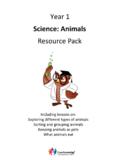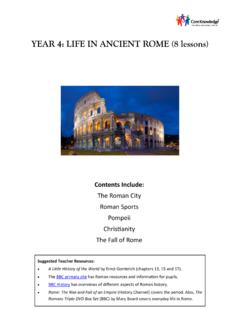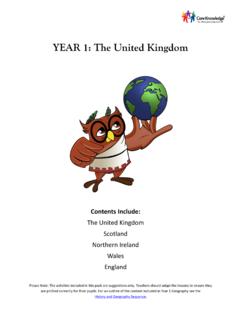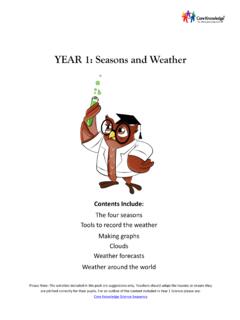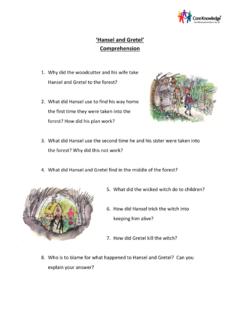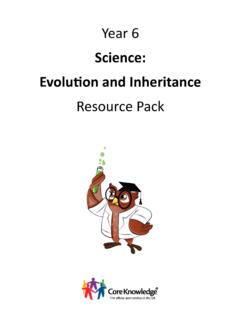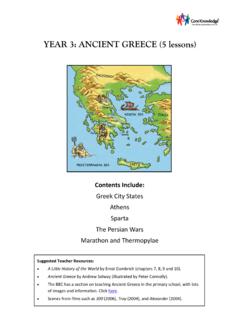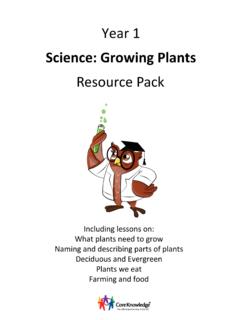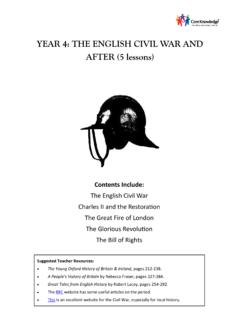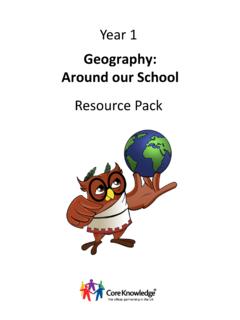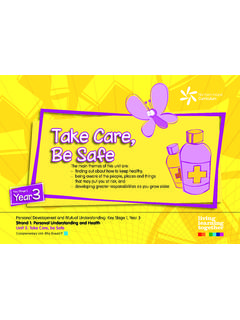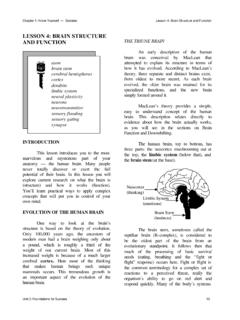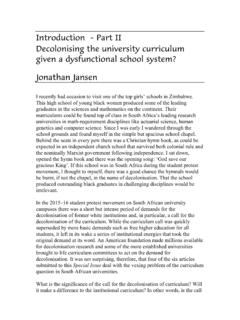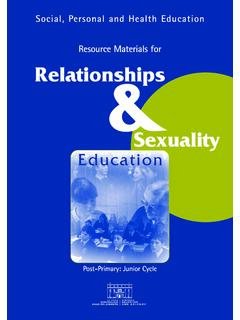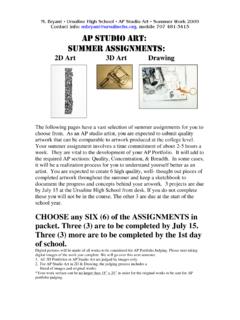Transcription of YEAR 1: The Human Body and Senses - Core …
1 year 1: The Human body and Senses Contents Include: What our bodies can do Eyes and Sight Ears and Hearing Touch, Taste and Smell Understanding Sensory Impairment Please Note: The activities included in this pack are suggestions only. Teachers should adapt the lessons to ensure they are pitched correctly for their pupils. For an outline of the content included in year 1 Science please see: year 1 Science Sequence Lesson 1: Prior Learning- Our Bodies The purpose of this lesson is to find out what children know about the Human body and Senses . Children may have knowledge of ways in which we can live a healthy lifestyle including what happens to our bodies when we exercise. Children may also be familiar with the concept of healthy eating. This unit will take children s learning on further and will introduce them to more of the scientific terminology associated with bodies and Senses . Children will also learn more detail about body parts such as the eye and the ear.
2 If basic knowledge of body parts is not secure then teachers should adapt this lesson, and the following lessons if necessary to ensure children understand this. This lesson has been designed to clarify what children know about their bodies and their Senses . The task should be completed independently in order to gain an accurate assessment of their knowledge and understanding. Any insecure knowledge can be addressed immediately after the assessment task. Learning Objective core Knowledge Activities for Learning Related Vocabulary Assessment Questions To show what I know about our bodies and our Senses . To know that we have five Senses : sight, hearing, touch, taste, smell. To know the body parts associated with our Senses . To understand that we can take care of our bodies by maintaining a balanced diet and exercising regularly. Give children a blank outline of a body - what do children know? What can they label?
3 This should be completed within approximately fifteen minutes as a prior learning assessment. Teacher to use information from walking around and looking at the work the children are producing to address any misconceptions. Task: Where possible use a mirror for children to look at their bodies, particularly their faces. Discuss what fantastic things our bodies can do. Complete worksheet explaining some of the things our bodies can do. Caring for Our Bodies: exercise, sports, healthy, fit, heart, sweat, clean, soap, bath, fruit, meat, vegetables, protein, fat, sugar, carbohydrate, vitamins, nutrients Our Bodies: ears, eyes, nose, mouth, arms, legs, head, skull, stomach, heart, fingers, toes, feet, hands etc. What can you tell me about our bodies? How can we make sure we look after our bodies? What are our Senses ? How do we use our Senses ? What happens when people s Senses are damaged or are not working? Resources: A4 Outline of body , vocabulary flashcards BBC Class Clips- A Healthy Diet for the Human body Name: Date: The Human body Prior Learning Assessment What can our bodies do?
4 Name: Date: Name: Date: Name: Date: Our Bodies- Option 2My can _____ _____. My can _____ _____. My can _____ _____. hear run chew jump listen skip hold touch clap sing taste My can _____ _____. Lesson 2: Eyes and Sight Teacher Knowledge: Sight is one of the most important Senses for finding out about the world around us. People use their eyes for almost every activity, from reading a book to riding a bicycle. The eye, our organ for sight, is a small sphere that is set in the skull in a protective socket. A small part of the eye is exposed which includes the sclera, cornea, iris and pupil. The sclera is the white part of the eye and the cornea is a thin, transparent tissue that covers the coloured part of our eye. The sclera and cornea act as protection against germs and particles such as dust that might harm your eye. The word sclera comes from the Greek word, skl ros meaning hard.
5 The iris is the coloured disc that is located behind the cornea; it absorbs any strong light that might damage your eye. The pupil is in the centre of your iris and is a small black opening. The amount of light that enters your eye is controlled by the pupil. There are two muscles in your eye that make the pupil larger or smaller depending on how much light is in the environment. Pupils will be larger when there is little light in the environment, however pupils will contract when you look at a bright light. Children do not need to be taught in this level of detail, but it is helpful if teachers have good subject knowledge in order to answer tricky questions. Learning Objective core Knowledge Activities for Learning Related Vocabulary Assessment Questions To know that the eye is an organ that we use to see. To understand that our eyes use light to help us see. To know some of the different parts of the eye and what their purpose is.
6 ( The eyelashes, eyelids and cornea protect the rest of the eye) To understand that sometimes people need help to see and that there are tools that help us to do so glasses, contact lenses, telescope, microscope. Introduce children to a diagram of the eye. Teach vocabulary for vision, eyelid, eyelash, pupil, iris (and sclera as an extension). Look at some images of eyes and identify key parts. Children could label a diagram on the IWB. Discuss how some people have different levels of vision- people who wear glasses/contacts etc. Also discuss how sometimes we need to help our eyes to see very small things a scientist might need to see a tiny little bug. In these situations we might need a microscope. Explain that we can also use tools to help us see things that are very far away looking at a planet through a telescope. Using magnifying glasses/microscopes to look at everyday objects from the classroom or outside.
7 What happens when we look through a microscope? Discuss night time/darkness- how easy is it to see? Explain that our eyes need light in order for us to see. In partners- one child to look at the other s pupil- cover eyes then look at a light (not too closely) and watch how their pupil changes. The pupil widens when it needs to let in more light and contracts when there is a lot of light. Discuss why we must not look at the sun. Sight: eye, iris, eyelid, eyelash, pupil, vision, reflection, glasses, contact lenses, telescope, microscope, blindness. How do we see? Describe how light helps us to see. What happens when someone needs help in order to see? Why is it important to look after our eyes? Resources: Diagram of the eye, magnifying glasses/microscopes. eyelid iris eyelash pupil Name: Date: Draw a picture of an eye here: Can you label it too? The Human Eye What do you know about our eyes?
8 Eyes and Sight Word Bank eye eyelid eyelash pupil iris glasses light contact lenses Eyes and Sight Word Bank eye eyelid eyelash pupil iris glasses light contact lenses Lesson 3: Ears and Hearing Our hearing allows us to gather important information about the world around us. We can take great pleasure from music, be alerted to danger by sirens and most importantly, can communicate with each other through speech. Our ears, the organ for hearing, allow us to use sound to interact with the world around us. The ear is made up of three parts, the outer ear, the middle ear, and the inner ear. The part of our ear we can feel on the outside of our head is called the auricle. The auricle is made up of fat and cartilage. Sounds are actually vibrations created by moving things. Particles vibrate creating sound waves that travel through the air or through other materials such as the ground or water. When the sound waves enter the ear they travel through the auditory canal to the eardrum and cause vibrations.
9 These vibrations cause the bones in the middle ear to vibrate, sending vibrations into the inner ear where the fluid and tiny hair cells move. This movement of the tiny hair cells in the cochlea create nerve impulses in the auditory nerve which are then transmitted to the brain. The brain interprets the impulses as sound and can tell which direction the sound came Objective core Knowledge Activities for Learning Related Vocabulary Assessment Questions To know that sounds travel through our ears to send messages to our brain. To know that sounds travel through our ears to send messages to our brain. To know that sounds can be very different, some loud and some quiet. To know that some people need help to hear and that some people cannot hear at all. Watch BBC Class Clip on Sound and Hearing- discuss. Go on a sound walk around and listen to all the sounds indoors and outdoors. Go back into the classroom and talk about what the children heard.
10 Read The Listening Walk, by Paul Showers, at an appropriate time in the lesson or during the day. Sound quiz- guess the sound from a collection of clips. Teach children that sounds move through the air in waves, and these waves travel through our ears. Our brains interpret the messages that the waves bring. Children can begin to understand that sounds are vibrations by gently placing their hand on their throat whilst humming a low sound. Investigate: which material would be most suitable for ear defenders for a person working in construction? Children could test out a range of materials including paper, foil, sponge, fabric, etc. Show children a clip of loud drilling to explain the need for ear defenders. Investigate: Can sound travel along a piece of string? Children could create cup telephones joined together by a piece of string. Discuss deafness, sign language and hearing aids. ear eardrum deaf hearing aid vibration sound wave speaker radio stereo microphone How do we hear sounds?
